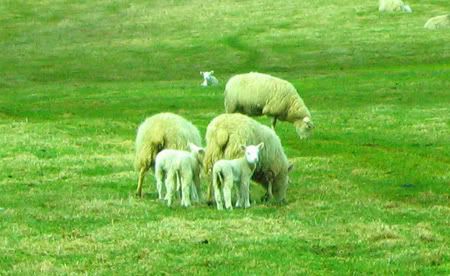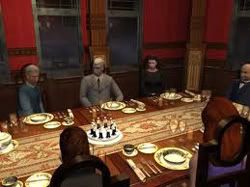Book Review: The Mark of the Lion by Suzanne Arruda
A dying soldier in the Great War in Europe extracts a promise from his friend, Jade, to track down his illegitimate half-brother, conceived when the now deceased family patriarch was exploring the Dark Continent.
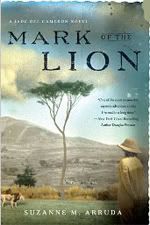 Set in 1919 British East Africa (now Kenya), amid colonial rule and racial unrest, Suzanne Arruda’s debut Mark of the Lion
Set in 1919 British East Africa (now Kenya), amid colonial rule and racial unrest, Suzanne Arruda’s debut Mark of the Lion introduces Jade del Cameron. A young woman raised on a New Mexico ranch and who served as an ambulance driver near the front lines in France in WWI, she is a perfect heroine. Just too perfect.
Not only is she beautiful with her green eyes (what are the chances?), black curls and olive complexion (her mother was Spanish), she has a “mellow contralto voice” (nothing too shrill for our Jade). She’s practical enough to wear trousers on safari while the other women wear skirts, she’s intelligent enough to finger a drug-smuggler and to uncover a murder. And she’s always in perfect control and understanding of her emotions so that men cannot sweep her off her feet without her consent.
Jade’s remarkably (& implausibly) free of the prejudices of the day, and of the condescension of the ruling people of whose society she is part. What’s more, she’s an ace-mechanic, a crack shot, and learns Swahili faster than just about anybody. She can out-climb, out-drive and out-think anybody around, but especially men.
There were many times I felt like gagging on yet another demonstration of her multiple, never-ending, and—oh yes, did I mention—perfect skills.

Be forewarned, the Kenya-set story involves witchcraft among some of the tribal people. Although the suggestion of that made me extremely uncomfortable while I was reading, I forged ahead thinking that perhaps the plot resolution would reveal another explanation of events. Alas, it did not. If you are offended by demonism, give this book a pass, as it is a key element upon which the plot turns.
At the story’s end, Miss del Cameron decides to stay on in Kenya, so future stories in this series may include witchcraft as well. Given that, and Jade’s oh-so-irritating perfection, I won’t be reading any more of Arruda’s novels, even though I did enjoy the historical setting of this series debut.
Link for my Canadian readers:
No Frackin’ Way!
URGENT:
Controversial Drilling Method Threatens Nova Scotia
So reads the front cover of a leaflet being distributed in our community by concerned citizens. Concerned about what?
 Fracking – or hydraulic fracturing, a method of extracting natural gas from deep underground. Energy companies drill deep wells, then pump in water mixed with sand and chemicals at high pressure. The water shatters the rock bed below ground and the sand keeps the cracks open, thus allowing natural gas to escape and be captured.
Fracking – or hydraulic fracturing, a method of extracting natural gas from deep underground. Energy companies drill deep wells, then pump in water mixed with sand and chemicals at high pressure. The water shatters the rock bed below ground and the sand keeps the cracks open, thus allowing natural gas to escape and be captured.
Fracking has been in use by the energy sector in the U.S.A. since 1947, and an estimated 90% of the natural gas wells there use hydraulic fracturing. So why the uproar?
Opponents of the process assert that very little research has been done on the long-term impact of fracking on human and wildlife health and on the environment. What are the problems?
1) The chemicals used in the fracking process (many of them carcinogens) and the natural gas itself can contaminate ground water – and in communities where most people rely on their own well for drinking water, that’s a tremendous concern.
 The producers of the film Gasland show many examples of ruined wells, including one where the water actually burns when lit. America’s Natural Gas Alliance (ANGA) maintains that these wells were contaminated by other sources, and prior to fracking activities in the area.
The producers of the film Gasland show many examples of ruined wells, including one where the water actually burns when lit. America’s Natural Gas Alliance (ANGA) maintains that these wells were contaminated by other sources, and prior to fracking activities in the area.
2) Fracking requires millions of gallon of water – local water – and thus could lower our ground water levels. Some home water wells may run dry and need to be re-drilled.
3) Much of the water used in the process returns to the surface, now contaminated with such hazardous chemicals as kerosene, benzene, toluene, and formaldehyde, and must be disposed of. The rest of the water and chemicals remains underground.
4) As in all mining operations, large areas of land (4 to 6 acres for each well pad) would be levelled, and roads for heavy equipment built. In a rural environment that depends on its natural beauty to draw visitors, as Nova Scotia does, tourism could decline dramatically.

5) Occasionally, a well will explode, spewing millions of gallons of hydraulic fracturing fluid and combustible gas into the air and onto surrounding landscape.
According to the New York Times, the NYC Department of Environment Protection refused to allow fracking within the NYC watershed, citing “an unacceptable threat to the unfiltered water supply of nine million people”.
And therein lies the rub: in the country, we’re not nine million people. We are only a few, and in the eyes of big business and government (and of people who do not live here), a few whose quality of life can be sacrificed.
This is one of the hazards of country living: unless you own ALL the land, potentially dangerous commercial enterprises can become your close neighbours. Sure, in the city, land might be cleared for a new mall or big box store but, as unattractive as they are, they don’t pose the hazard of a natural gas well, fracking the earth beneath you.
 In Nova Scotia, there will be a demonstration held in front of Province House in Halifax between 1 and 2 p.m. today, to mark Earth Day and to officially register the groundswell of protest against fracking in Nova Scotia.
In Nova Scotia, there will be a demonstration held in front of Province House in Halifax between 1 and 2 p.m. today, to mark Earth Day and to officially register the groundswell of protest against fracking in Nova Scotia.
Book Review: Agatha Christie’s Secret Notebooks by John Curran
During her amazing half-century-plus writing career, author Agatha Christie jotted notes and ideas for her work in various notebooks and journals. Seventy-seven of these notebooks were discovered by her heirs after her death. Although they are certainly not a complete collection of the scribblers she used, they shed much light on how Christie created her masterpieces.
 The notebooks contain character lists, suggested settings, and plot ideas and development, but until now they have been largely ignored, mainly because Christie’s handwriting is nearly illegible. As John Curran worked with the material in preparing Agatha Christie’s Secret Notebooks: Fifty Years of Mysteries in the Making
The notebooks contain character lists, suggested settings, and plot ideas and development, but until now they have been largely ignored, mainly because Christie’s handwriting is nearly illegible. As John Curran worked with the material in preparing Agatha Christie’s Secret Notebooks: Fifty Years of Mysteries in the Making, he became familiar with her scribbles and unlocked fascinating insights into the woman and author Christie.
The Secret Notebooks opens with several chapters of summary, giving an overview of Christie’s work, her characters, and her influences, among other things. These chapters I read completely.
I learned why Christie was so successful and remains so popular. She was immensely productive and eminently readable. Curran also points out the secret of the plots that entrance Christie’s readers:
The secret of her ingenuity with plot lies in the fact that this dexterity is not daunting. Her solutions turn on everyday information–some names can be male or female, a mirror reflects but it also reverses, a sprawled body is not necessarily a dead body, a forest is the best hiding place for a tree. She knows she can depend on our erroneous interpretation of an eternal triangle, an overheard argument or an illicit liaison. She counts on our perceived prejudice that retired Army men are harmless buffoons, that quiet, mousy wives are objects of pity, that all policemen are honest and all children innocent. She does not mystify us with the mechanical or technical…
In almost every Christie title the mise-en-scene features a closed circle of suspects–a strictly limited number of potential murderers from which to choose. A country house, a ship, a train, a plane, an island–all of these provided her with a setting that limits the number of potential killers and ensures that a complete unknown is not unmasked in the last chapter.
He also touches on what I have always considered a touchstone of a good mystery book – the fairness.
Throughout her career Christie specialised in giving her readers the clues necessary to the solution of the crime. She was quite happy to provide the clue, firm in the knowledge that, in the words of her great contemporary R. Austin Freeman, ‘the reader would mislead himself’.
The bulk of the book, however, discusses the notes on individual books and contains many spoilers. I found interesting the comparison of plots and plot devices, and settings in various books.
Last fall, I read several of Christie’s novels, checking Fantastic Fiction to find the titles of her earliest works, and thinking to start at the beginning of my collection. I thus completed The Mysterious Affair at Styles (1920), The Man in the Brown Suit (1924), The Secret of Chimneys
(1925), Partners in Crime (1929), and Sad Cypress
(1940). Reading the plans behind these, and Curran’s intelligent analysis of Christie’s background work, was fascinating.
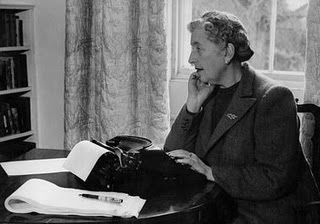
I borrowed Agatha Christie’s Secret Notebooks from the library, but I want to buy a copy for own bookshelf. I plan to put it beside my collection of Christie’s works and to consult it upon finishing one, when the characters and plot intricacies are fresh in mind. As Curran points out: it is possible to read a different Christie title every month for almost seven years; and at that stage it is possible to start all over again safe in the knowledge that you will have forgotten the earliest.
And so Christie’s work continues to transcend every barrier of geography, culture, race, religion, age and sex; she is read as avidly in Bermuda as in Balham, she is read by grandparents and grandchildren, she is read on e-book and in graphic format in this twenty-first century as eagerly as in the green Penguins and The Strand magazine of the last. Why? Because no other crime writer did it so well, so often or for so long; no one else has ever matched her combination of readability, plotting, fairness and productivity.
And no one ever will.
Amen to that.
Links for my Canadian readers:

Agatha Christie’s Secret Notebooks: Fifty Years of Mysteries in the Making
The Mysterious Affair at Styles: A Hercule Poirot Mystery
Secret Of Chimneys: a Hercule Poirot Mystery
Sad Cypress: a Hercule Poirot Mystery
P.S. If you click through the affiliate links in the book titles, you may notice a different cover. I like to see the cover that’s on the copy I read – and it’s usually different than Amazon.com because they display the American release, and I read the Canadian. Again, the links are affiliate links so I will receive a small percentage of any purchase you make after clicking through from this blog.
Afternoon Sighting
I was out doing some volunteer work yesterday afternoon and came across this curious bovine in the barn at the edge of a dooryard. Not something I saw very often in the city…
![]()
Can’t get enough cows? Check out CowParade – Moo-ti-cultrural! Shop Today!
Book Review: A Fine Balance by Rohinton Mistry
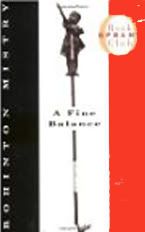
Rohinton Mistry’s third novel, A Fine Balance (1995), won the second annual Giller Prize in 1995, and in 1996, the Los Angeles Times Book Prize for Fiction. It also snagged the 1996 Commonwealth Writers Prize, the Royal Society of Literature’s Winifred Holtby Award, and Denmark’s ALOA Prize, and was shortlisted for the 1996 Booker prize. It was selected for Oprah’s Book Club in November 2001. All for good reason.
Set in 1975 India during “The Emergency” when the Prime Minister, Indira Gandhi, “ruled by decree”, A Fine Balance tells the stories of four people who, because of circumstances, end up living together in a small flat.
Dina Dalal, a fortyish widow who grew up in a wealthy family and who jealously guards her independence from her merchant brother, is the official tenant of the flat.
Maneck Kohlah grew up in a small mountain village near the Pakistan border. His father owned the local general store and sold his secret formula Kohlah’s Cola. When the highway comes through the village, his father’s business suffers because of the importation of mass-produced soft drinks.
At seventeen, wanting a career independent of his father, Maneck decides to attend college in the city and obtain a certificate as an air-conditioning technician. Maneck’s mother was a school-mate of Dina’s, and so arranges for Maneck to board with her at her flat.
Uncle and nephew, Ishvar and Omprakesh Darji, members of the Chamaar caste, considered untouchables, have come to the city to start a new life after a family tragedy of barbaric cruelty. Trained as tailors, they are hired by Dina to sew piecework from patterns provided by an export company. Initially, they only work at Dina’s flat and do not live there. After a series of misfortunes, they end up sleeping in Dina’s veranda, bathing in her washroom, and eating meals with Dina and Maneck.
The co-existence of these strangers from disparate backgrounds begins tenuously but with a little choice.
…in a city where millions were living in slums and on the pavements. And not just beggars–even people with jobs who had the money to pay the rent. Only, there was nothing to rent.

The backstories of these characters create a depth of understanding in the reader and as their story unfolds, we feel emotionally invested in their future.
Even though the characters are skilfully and deeply drawn, A Fine Balance is not simply a character study. There is a blockbuster of a plot filled with the small triumphs and large tragedies of human existence. Although it would seem that India’s political affairs would be the “big picture” of this novel, the effects of those affairs on the population are so dramatic that the fabric of people’s lives becomes the greater theme.
 Mistry has made India live. The heat, the dust, the hunger and the thirst, the crowding, poverty, disease, and corruption become real to the reader. Even so, we are appalled when Dina’s brother, a member of the urban merchant or commercial class, says:
Mistry has made India live. The heat, the dust, the hunger and the thirst, the crowding, poverty, disease, and corruption become real to the reader. Even so, we are appalled when Dina’s brother, a member of the urban merchant or commercial class, says:
My friend was saying last week…that at least two hundred million people are surplus to requirements, they should be eliminated…you know–got rid of. Counting them as unemployment statistics year after year gets us nowhere, just makes the numbers look bad. What kind of lives do they have anyway? They sit in the gutter and look like corpses. Death would be a mercy.
Ultimately, A Fine Balance is about man’s inhumanity to man and the indomitableness of the human spirit. There’s plenty of heartache here. The tragedy, sorrow, and loss could overwhelm some readers: this is not a book for those looking for a happy ending. As Maneck, ever the student of air-conditioning observes:
If there was a large enough refrigerator, he would be able to preserve the happy times…, keep them from ever spoiling…but it was an unrefrigerated world. And everything ended badly.
A Fine Balance is a sweeping and powerful novel that has been compared to works of Tolstoy or Dickens. It is a rich study of a difficult time in India’s history, featuring complex and flawed characters.
It will certainly remain on the list of the best books I’ve read this year – perhaps even in my lifetime. I cannot recommend it enough. Five out of five stars.
Link for my Canadian readers:
A Fine Balance
P.S. If you click through the affiliate links in the book titles, you may notice a different cover. I like to see the cover that’s on the copy I read – and it’s usually different than Amazon.com because they display the American release, and I read the Canadian. Again, the links are affiliate links so I will receive a small percentage of any purchase you make after clicking through from this blog.
Friday 08Apr11: The View from My Office – Sticks & Stones
Is spring really here? There’s only a few low clouds in a beautiful blue sky and although the temperature is only just above freezing, the sun is warming the earth.
![]()
To the right, you can see the tamarack trees at the end of our drive. They are the only coniferous tree in Canada to lose their needles in the winter. I love them for it, although I’m glad that other species stay evergreen so we have some color during the winter months. No buds yet – but soon, soon!
Breaking Ground for Books
The home page of our regional library proudly displays the headline: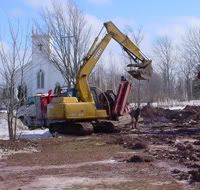
Excitement in Tatamagouche!
The first steps have begun toward building the new Tatamagouche branch.
I’ve been by the site and the earth where the building will go has been dug up, although nothing more seems to have been done in the last couple of weeks. It’s very exciting for our village, although it has not been without controversy.
The location of the new structure was the biggest issue under debate. Many favoured a location on the main street next to the Raven Gallery, where a burned out variety store has been razed.

The chosen building site is considered by many to be out of the way, being half a mile down the road and out of the village centre proper. I believe that parking availability was the strongest deciding factor.
It is exciting to see this project finally off the ground and I’m curious to watch as the building goes up. 
But I’m sure I’m not alone in saying that many will miss the old site, as tiny and impractical as it is. The size has never bothered me, since I reserve books on-line, and can read books from all over the province through the inter-library loan system.
Still, it must be quite difficult, if not impossible, to have a kids’ story-time session in the current premises, or for more than one student at a time to research or study (do students still use libraries?)
Always trade-offs. That’s progress – and life.
Book Review: Mr. Shakespeare’s Bastard by Richard B. Wright
Richard B. Wright’s 2001 novel, Clara Callan was a masterpiece that won Canada’s two most prestigious literary awards – the Governor General’s Award and the Giller Prize.
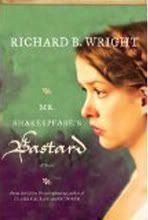 I have tried to not to measure the author’s subsequent works by that book, but I admit that my expectations were high when I started his latest offering, Mr. Shakespeare’s Bastard
I have tried to not to measure the author’s subsequent works by that book, but I admit that my expectations were high when I started his latest offering, Mr. Shakespeare’s Bastard.
Unfortunately, this book fell far short of my expectations and I finished it mainly because it was this month’s choice for our local book club, The Loquacious Compendium.
From the dust jacket:
In failing health, Aerlene Ward, an elderly housekeeper in an Oxfordshire manor, feels compelled to confess the great secret that has shaped her life: she is the illegitimate daughter of William Shakespeare, England’s most famous playwright. But will anyone believe her? Even Charlotte, the young mistress of the house who is writing Aerlene’s words down, is doubtful.
Wright tells a plausible story about Aerlene’s mother meeting and mating with Shakespeare. I’d be very surprised if the real Shakespeare didn’t have more “bastards”, so that revelation in itself is certainly not enough to carry this story. In fact, my complaint about this book is that there is no story. What happens is summed up on the dust jacket.
That said, there were some in our book club who agreed with this blurb:
With a brilliant eye and ear for this rich period of history, Richard B. Wright vividly evokes the seasonal rhythms of rural life in Oliver Cromwell’s England and the teeming streets of Shakespeare’s London as he interweaves the two women.
Certainly, Wright captures the female point of view beautifully and uses it often in his writing. This book is no exception. It’s easy to forget as one reads about Aerlene & her mother Elizabeth that the book has a male author. The female voice is amazingly authentic.
 But the blurb also promises that “secrets are revealed, mysteries are uncovered, and futures are forever changed.” Sorry, I didn’t see that. What you’ve found out here is what happens. It’s a glimpse at seventeenth century England, especially London. There’s a brief introduction to Shakespeare, although he plays a minor role and is used mainly as a plot device (and title).
But the blurb also promises that “secrets are revealed, mysteries are uncovered, and futures are forever changed.” Sorry, I didn’t see that. What you’ve found out here is what happens. It’s a glimpse at seventeenth century England, especially London. There’s a brief introduction to Shakespeare, although he plays a minor role and is used mainly as a plot device (and title).
Since the book is well-written, it was suggested at our book club discussion that it might be a good Young Adult choice. However, Elizabeth’s morals leave much to be desired and her actions might not be appropriate reading for that age group.
Overall, I was very disappointed by Mr. Shakespeare’s Bastard, but you might be an historical fiction fan who will find it:
An engaging blend of invention and historical detail, a novel full of imagination and delicate emotion.
Many in The Loquacious Compendium did.
Links for my Canadian readers:
P.S. If you click through the affiliate links in the book titles, you may notice a different cover. I like to see the cover that’s on the copy I read – and it’s usually different than Amazon.com because they display the American release, and I read the Canadian. Again, the links are affiliate links so I will receive a small percentage of any purchase you make after clicking through from this blog.
Books Read in March 2011
 A road trip to Ontario gave me some riding time for reading. Here’s what I got through in March; four of the ten are by Canadian authors.
A road trip to Ontario gave me some riding time for reading. Here’s what I got through in March; four of the ten are by Canadian authors.
1. Man in the Queue by Josephine Tey
Set in 1929 in London’s theatre district, the first in the Inspector Alan Grant series. Grant is presented with an unidentified body found in the ticket line for a musical comedy. He must first discover who the victim is before he can find who killed him and why. My review is here.
2. Alligator: A Novel by Lisa Moore
You can read my review of this novel set in modern-day St. John’s Newfoundland here. I just picked up Moore’s February from the library and I’m looking forward to cracking it open next week.
3. Family Matters by Rohinton Mistry
Set in modern-day Mumbai India, this story of family patriarch Nariman Vakeel, an elderly widower of the Parsi minority, who lives with his two middle-aged stepchildren gives us a good look at that city. Although quite interesting, it’s not up to A Fine Balance.
4. The Awakening by Kate Chopin
1899 classic set in and around New Orleans, this chronicles the cultural and sensual revolution that takes place inside one society woman.
5. Mr. Shakespeare’s Bastard by Richard B. Wright
The latest from the author of award-winning Clara Callan, this book is set in 17th century Oxfordshire & London, England. You can see what I thought of it.
6. An English Murder by Louise Doughty
Also called Honeydew, this story is set in modern-day rural England and involves the murder of a middle-aged couple by their teenage daughter. Said to be a soft spoof of English murder mysteries, it didn’t satisfy as either that or a real mystery.
7. A Fine Balance by Rohinton Mistry
Compared by critics to Tolstoy, this book is one of the richest I have read. You can find my review here.
8. Building the Pauson House: The Letters of Frank Lloyd Wright and Rose Pauson – foreward by Allan Wright Green
A beautiful win from the publisher. See my review here.
9. Agatha Christie’s Secret Notebooks: Fifty Years of Mysteries in the Making by John Curran
Non-fiction analysis of the notebooks that Christie used in plotting many of her books. Fascinating – and one I want for my own bookshelf. Here’s my thoughts.
10. The Coffin Trail by Martin Edwards
First in the Lakes District series featuring DCI Hannah Scarlett and historian Daniel Kind, this modern-day crime mystery is oddly named but enjoyable. I’ll likely read more in the series.
Links for my Canadian readers:
The Man in the Queue
Alligator
Family Matters
The Awakening
Mr. Shakespeare’s Bastard
An English Murder
A Fine Balance
Building the Pauson House: The Letters of Frank Lloyd Wright and Rose Pauson
Agatha Christie’s Secret Notebooks
The Coffin Trail
Or better yet, buy from a independent book seller.
Buy from an independent book seller by searching this site that has links to independent booksellers across North America.
P.S. If you click through the affiliate links in the book titles, you may notice a different cover. I like to see the cover that’s on the copy I read – and it’s usually different than Amazon.com because they display the American release, and I read the Canadian. Again, the links are affiliate links so I will receive a small percentage of any purchase you make after clicking through from this blog.
Sites worth a visit
Living in the country resources
Reading & Book-related Connections
- Dwell In Possibility
- Fleur Fisher in Her World
- Desktop Retreat
- In So Many Words
- Heavenali
- Lakeside Musing
- A Work in Progress
- A Penguin a Week
- Mary Okeke Reviews
- Buried in Print
- Desperate Reader
- Diary of a Word Nerd
- Amy Reads
- Rebecca Reads
- Kittling: Books
- Reading Matters
- Book Chase
- JoV's Book Pyramid
- Dog Ear Discs
- Pining for the West
- A Striped Armchair
- Books Please
- Under My Apple Tree
- Reader Buzz
- Beth Fish Reads
- Utter Biblio
- New Dork Review of Books
- Stuck in a Book
- Page Plucker
Other Cool Blogs
Videos to touch your heart
